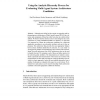Free Online Productivity Tools
i2Speak
i2Symbol
i2OCR
iTex2Img
iWeb2Print
iWeb2Shot
i2Type
iPdf2Split
iPdf2Merge
i2Bopomofo
i2Arabic
i2Style
i2Image
i2PDF
iLatex2Rtf
Sci2ools
117
click to vote
AOSE
2005
Springer
2005
Springer
Using the Analytic Hierarchy Process for Evaluating Multi-Agent System Architecture Candidates
Abstract. Although much effort has been spent on suggesting and implementing new architectures of Multi-Agent Systems (MAS), the evaluation and comparison of these has often been done in a rather ad-hoc fashion. We believe that the time has come to start doing this in a more systematic way using established methods. For instance, we argue that it is important to evaluate the architecture candidates for a particular application according to several quality attributes relevant to that application. The architecture that provides the most appropriate balance between these attributes should then be selected. As a case study we investigate the problem of load balancing and overload control of Intelligent Networks and present four MAS architectures that can be used to handle this task. We instantiate each of these and define metrics for the selected quality attributes. The instantiations are studied in simulation experiments and measurements of the metrics are recorded. The measurements are ...
Related Content
| Added | 26 Jun 2010 |
| Updated | 26 Jun 2010 |
| Type | Conference |
| Year | 2005 |
| Where | AOSE |
| Authors | Paul Davidsson, Stefan J. Johansson, Mikael Svahnberg |
Comments (0)

